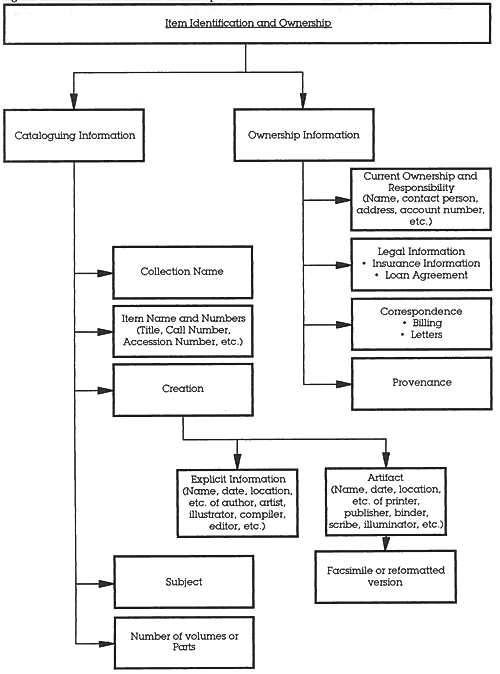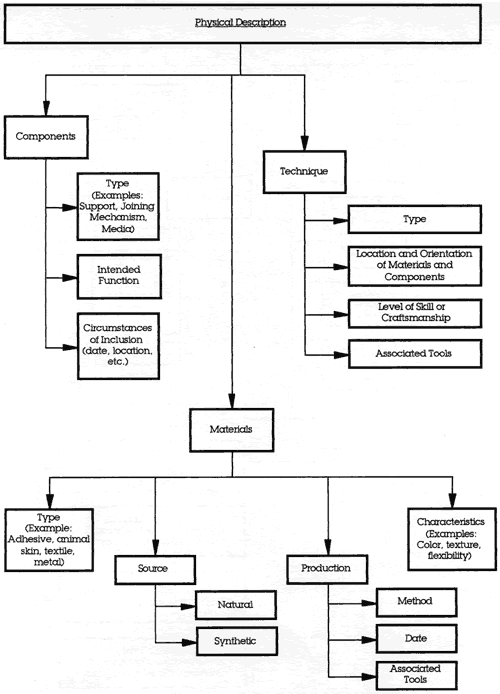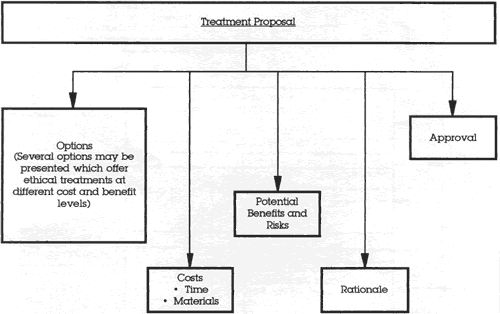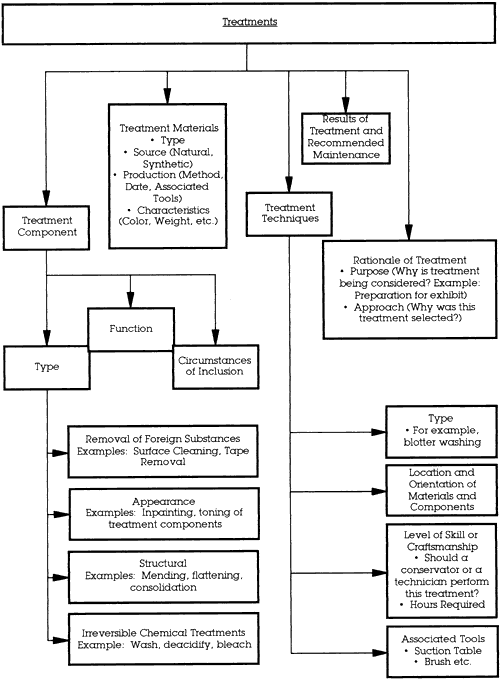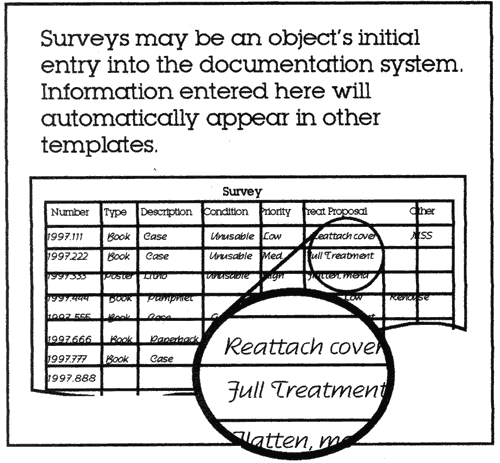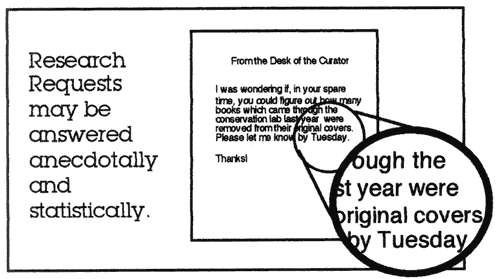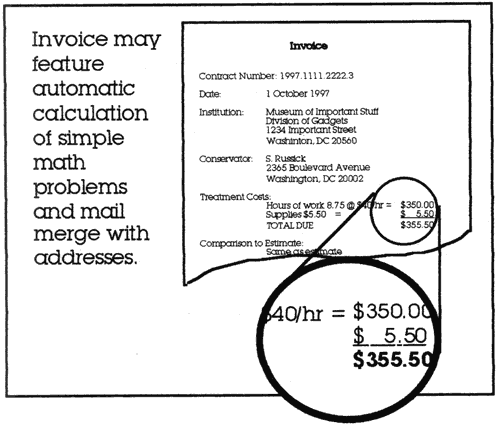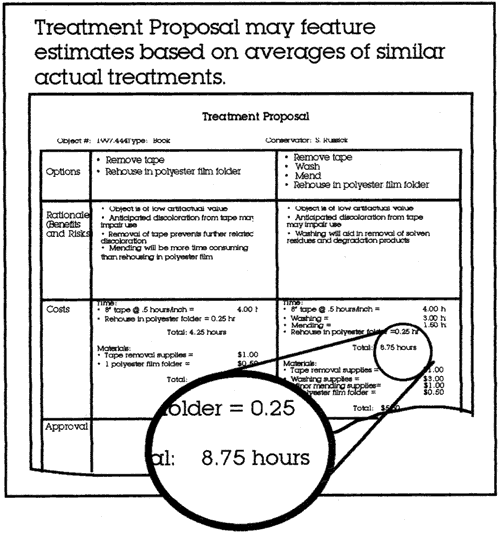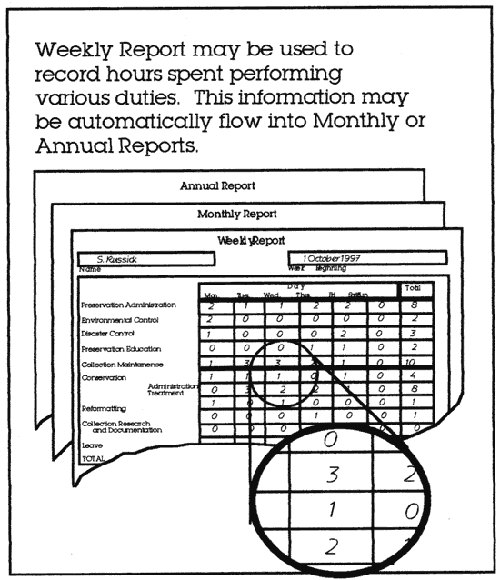A Prototype System to Document Book Conservation
by Susan RussickObjectives and Organization
The AIC includes in its Guidelines for Practice a mandate to document examinations and treatments. Unfortunately, documentation is a tedious and time-consuming process which is inherently unable to record the physical object, its condition, or treatment completely. Because electronic records remain vulnerable to loss, paper files must be maintained. the difficulty of coordinating word-processing programs, hand marked checklists, surveys, slides and samples has resulted in documentation procedures which underutilize the computer's searching and cross-referencing abilities. Access to these records is often thwarted even when this technology is used properly because terminology is inconsistent. Different conservators or communities of conservators may, for example, prefer the term "gathering" rather than "signature," "section" or "quire." Variation in spelling or capitalization may make otherwise consistent terminology impossible to navigate (for example: Color, color, colors, colour, colored). This prototype is a work-in-progress which attempts to address these issues. It endeavors to be comprehensive, time efficient, clearly organized, consistent in the use of terminology, and accessible by both computer (for ease of searching) and paper (for greater permanence).
The prototype currently consists of an evolving series of FileMaker Proä documentation templates and a user manual. When complete, the system will be small enough to run on a laptop, yet able to be merged with larger databases; compatible with IBM and Macintosh; and able to import digitized images. the resulting database will be readily searchable and accessible in both paper and digital formats, providing quantifiable and anecdotal information.
Although all classification schemes are awkward, this prototype attempts to provide a logical place for all relevant information. This prototype is systematically organized into the information groups identified in the following flowcharts (see figures 1-7). the flowcharts were designed as a conceptual organization of the information needed in documentation. the templates that follow the flowcharts are initial attempts at practical formats for retrieving and printing that information.
- Figure 1: Item Identification and Ownership Flowchart
- Cataloguing or registration information, contact person, etc.
- Figure 2: Preservation Information Flowchart
- Administrative information, value, selection, presence of hazardous materials, storage and handling history. This section inherently includes disaster planning.
- Figure 3: Physical Description Flowchart
- Components, materials and techniques involved in each part of the book.
- Figure 4: Change in Condition Flowchart
- Type of change (change to appearance, structure and the presence of foreign substances), causes of change (internal and external), location and severity of change.
- Figure 5: Testing and Analysis Flowchart
- Observations from solubility or sensitivity tests, microscopy, method of determining pH, etc.
- Figure 6: Treatment Proposal Flowchart
- Options, costs, rationale and approval.
- Figure 7: Treatment Flowchart
- Components, materials, techniques and results of treatment, including costs in hours and supplies.
Templates and Applications
The systematic classification scheme of this prototype provides a logical place for all relevant information. However, all information is not relevant in every instance. the importance or complexity of the object or treatment will determine the level of detail recorded. Templates, specifically designed to document different aspects of book conservation, may combine items from different information groups or may use only part of one group. the templates feed into a single database, therefore, if the most detailed template is completed, all other templates may be printed without adding or re-typing any information. for example, an invoice may require the owner's name and address, the conservator's name and address, a brief description of the object, the treatment, and cost of treatment. All of these bits of data, drawn from different information groups, are merged automatically. Templates may also involve only one information group. for example, predicting the average time required to recase a book may be calculated by using actual times from completed treatment reports. the conservator can select or design different templates which will cue him or her to observe and document in varying degrees of detail, as needed. See Figure 8: Template Examples.
- Detailed Examination and Treatment Template
- In an ideal world, a high level of detail would be afforded to each object. However, it is more likely that only portions of an object will demand this degree of scrutiny. Portions of this painstaking report may be practically used in conjunction with shorter templates. for example, if the treatment is to re-attach a page, then it may be appropriate to describe the cover at a lower level of detail, while retaining a high level for the text block and leaf connection.
- Regular Examination and Treatment Template
- A template of an appropriate level of detail and length for most complete treatments.
- Checklist Template
- A brief template used for routine treatments and linked to a detailed description of that routine treatment.
- Survey Template
- Allows information gathered at the collection level to be associated with individual items.
- Book Plate or Flag Template
- An abbreviated description of the treatment which is designed to stay with the book on the shelf. Primarily consisting of a list of materials used, the date of treatment, and who to contact for more information.
- Tracking of Materials and Time Template
- Form letters and invoices may be used for charging customers or departments, ordering supplies or estimating future treatment costs.
- Tracking of Treatments Template
- Records the types of treatments performed, their success over time, and scheduled maintenance.
- Flat Paper and Other Types of Conservation
- This classification scheme may be adaptable for other types of objects, most obviously, flat paper.
Figures
Figure 1: Item Identification and Ownership
Figure 2: Preservation Information
Figure 3: Physical Description
Figure 4: Change in Condition
Figure 5: Testing and Analysis
Figure 6: Treatment Proposal
Figure 7: Treatments
Figure 8a: Template Example
Figure 8b: Template Example
Figure 8c: Template Example
Figure 8d: Template Example
Figure 8e: Template Example
Susan RussickBook and Paper Conservator
Publication History
Received: Fall 1997
Poster delivered at the Book and Paper specialty group session, AIC 25th Annual Meeting, June, 1997, San Diego, California.
Posters for the specialty group session are selected by committee, based on abstracts and there has been no further peer review. Papers are received by the compiler in the Fall following the meeting and the author is welcome to make revisions, minor or major.
